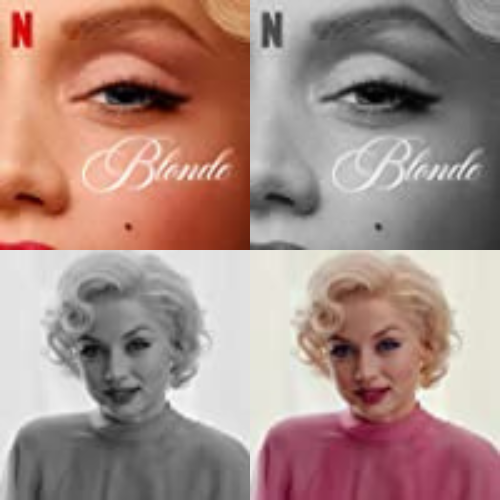Netflix’s “Blonde” exploits and erases Marilyn Monroe’s truth

Staff Graphic by Sophia Fisher
Ana de Armas as Marilyn Monroe in Netflix’s new movie “Blonde”
Warning: The following article contains graphic depictions of rape, sexual assault, miscarriage, and abuse that some readers may find triggering.
Even in death, Marilyn Monroe can’t escape sexualization and exploitation. Netflix’s new movie “Blonde” directed by Andrew Dominik, attempts to display the life of Norma Jeane Baker, famously known as Marilyn Monroe, but ultimately diminishes Monroe to a victim instead of showing her multifaceted life and career. Dominik’s movie romanticizes abuse by dramatizing Monroe into a fictional character with very little relation to the historical icon.
The very first moment of Monroe’s career that an audience sees is of her being raped by movie executive, Darryl F. Zanuck, after which she is cast in his movie for her debut. Although non-consensual sexual encounters were common between producers and starlets at the time, this particular event as portrayed in the movie was false. Monroe got her start in the performance industry as a model, which led to a short-term contract with Twentieth Century Fox Studios. Her interactions with Zanuck were never spoken of by her, or any related party, as sexual. Beginning “Blonde” with such a violent rape scene set the stage for the abusive singularity of the movie and begins the pattern of reducing Monroe’s success to her pain.
This pattern is concluded in one of the ending scenes where Monroe is forced into multiple graphic, aggressive and intimate moments with former President John F. Kennedy. This event was never proven, and was pulled completely from rumors. Monroe sang “Happy Birthday” to President Kennedy in Madison Square Garden and was photographed with him once for that same event, which led people to believe that she was having an affair with him. By allowing a false depiction of Monroe and Kennedy’s relationship to be a traumatizing part of “Blonde” and using it as a driving force for the completion of the movie, the movie executives make it clear that “Blonde” is not about representing the real Marilyn Monroe and is instead about exploiting her abuse for profit.
“Blonde” also exploits Marilyn Monroe by romanticizing her extremely traumatic miscarriages. The movie blatantly displays her pregnancies twice and both times the story is told through the fetus. When she has her miscarriage in the movie, the fetus is shown being enveloped by blood and a crying baby can be heard. Monroe had three documented miscarriages during her marriage to playwright Arthur Miller. However, the presentation of her miscarriages in “Blonde” ignore her strength to continue filming throughout these and instead focused on exaggerating her depression following her third miscarriage. Furthermore, “Blonde” depicts Monroe as having two abortions, both of which were forced. Monroe has never been documented as having an abortion and the movie’s false portrayal of it is vulgar. Monroe is shown thrashing on the doctor’s table, begging for it to stop. She says repeatedly that she doesn’t want an abortion but is ignored. One of the abortion scenes is even filmed from inside her uterus. These scenes dramatize Monroe’s pain for viewers’ entertainment without care for the exploitative nature of the portrayal.
Even the historically accurate parts of “Blonde” dramatize the events into vulgarity. Marilyn Monroe’s childhood was traumatic and her mother, Gladys Pearl Baker, did have mental issues. However, the movie’s portrayal of their relationship is heavily exaggerated, such as one scene where Baker attempts to drown Monroe, only furthering the abuse-focused theme of the movie as well as creating an unhelpful stigma of mental illness by correlating it so strongly with abuse. Dominik’s portrayal of Monroe’s marriage to Joe DiMaggio also furthers the darkness of “Blonde” without adding much to the movie’s progression. DiMaggio was reportedly abusive, and while bringing those actions to light is very important, by manipulating the timeline of Monroe’s life to only show her in a relationship, Dominik ends up romanticizing Monroe’s trauma without showing how it affected her or how she overcame that struggle and became such a powerful woman.
Overall “Blonde” has beautiful cinematography and compelling acting. The use of distortion in Monroe’s obsessive fans shows the greed she had to deal with and Ana de Armas’ portrayal of Monroe incited sympathy in all who watched. The writing and production of a story that was meant to be a biopic of Marilyn Monroe’s life left much to be desired. However, the movie showed no progress on Monroe’s part and instead turned her into a receptacle of pain and abuse for other characters. Exposing the evil deeds of abusers is important, but “Blonde” takes the intent of justice and representation and uses it to create a psychological thriller that continues to exploit the woman it claims to be defending.








Millie Monahan • Oct 28, 2022 at 1:06 pm
absolutely fantastic:)) go best friend!!!